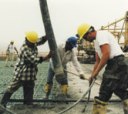
Report: Hispanics Dying on the Job at Higher Rates than Others
Hispanics are among the fastest-growing segments of the U.S. workforce, and they also have a higher work-related injury death rate than all other workers. According to the top story in today's MMWR (www.cdc.gov/mmwr), the annual work-related injury death rate for Hispanic workers exceeded the rate for all U.S. workers every year from 1992 through 2006, with the exception of 1995. In 2006, the rate for Hispanic workers was 5.0 per 100,000 Hispanic workers, compared with rates of 4.0 for all workers, 4.0 for non-Hispanic white workers, and 3.7 for non-Hispanic black workers. Significantly, the report points out that, from 2003 to 2006, the work-related injury death rate for foreign-born Hispanic workers was 5.9, compared with a rate of 3.5 for U.S.-born Hispanic workers.
Commenting on the MMWR report in a teleconference yesterday, NIOSH's Dr. Sherry Baron, coordinator of the Occupational Health Disparities Program, noted that the largest portion of deaths among Hispanic workers during the study period occurred in the construction industry, representing about one-third of all deaths. "Since 1997, the most common causes of deaths have been highway incidents and falls to a lower level," Baron said. "Falls have emerged as an increasingly important cause of work-related injury deaths and was the number one cause in 2006. The number of falls as a cause of death increased 370 percent between 1992 and 2006."
Baron added that based on available information, the higher rates of Hispanics' job-related deaths result from a combination of factors. "Clearly the most important factor is that they are disproportionately working in riskier jobs such as construction. Other factors include inadequate control of recognizing safety hazards and inadequate training and supervision of workers, which is often exacerbated by issues of language and literacy, especially for foreign-born Hispanic workers," she said.
Scott Richardson, director of the Bureau of Labor Statistics' Census of Fatal Occupational Injuries, noted that Hispanics' higher work-related death has correlated to their growth in the U.S. population. "If you look at just demographic trends, in 1980 only three percent of the U.S. population was Hispanic, and in 2005 nearly 15 percent were Hispanic, so that's been quite a growth, driven primarily by immigration in the Hispanic population of the U.S.," he said.
The MMWR report includes a table of work-related injury data by selected states. According to the table, Calfornia and Texas had the highest number of Hispanic work-related deaths from 2003 to 2006, with 773 and 687 deaths, respectively. Given the Hispanic segment of the population in those states, however, the fatality rates in both states were actually below the national average. With 51 deaths during the period, South Carolina had the highest work-related injury death rate at 22.8.
Baron observed that putting a stop to this fatal trend in the Hispanic community will require concerted efforts by employers, safety and health agencies, researchers, unions, community groups, and the workers themselves. "These efforts should be aimed at ensuring safe work environments and providing safety education and training of Hispanic workers that is linguistically and culturally appropriate," she said, adding that NIOSH has initiated several efforts to accomplish this, including new training materials in Spanish and the funding of several outreach programs with culturally tailored messages. She said NIOSH, in collaboration with state agencies, has investigated more than 200 deaths among Hispanic workers, and used the data to generate in-depth recommendations to prevent similar deaths, primarily through training and intervention programs that target foreign-born workers.